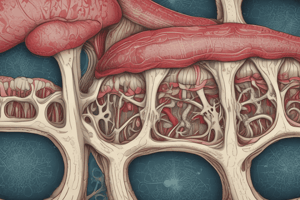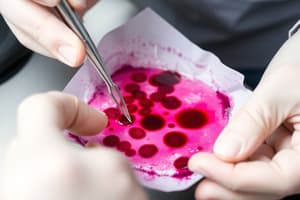Podcast
Questions and Answers
What is a key benefit of using microwave ovens specifically designed for tissue processing?
What is a key benefit of using microwave ovens specifically designed for tissue processing?
- They are more energy-efficient than conventional ovens.
- They are easier to maintain than kitchen-type microwaves.
- They provide better controls and even energy distribution. (correct)
- They reduce the time required for tissue fixation.
Which fixative combination is stated to allow for the recovery of DNA, RNA, and proteins for molecular analyses?
Which fixative combination is stated to allow for the recovery of DNA, RNA, and proteins for molecular analyses?
- Formaldehyde with microwave-based processing
- Methanol with polyethylene glycol
- Traditional formalin-based fixations
- Alcohol-based fixative with formalin-free processing (correct)
What is a notable effect of using the universal molecular fixative (UMFIX) on tissue morphology?
What is a notable effect of using the universal molecular fixative (UMFIX) on tissue morphology?
- It allows for better preservation of low-molecular weight RNA.
- It completely prevents any staining artefacts in tissues.
- It significantly alters the structural integrity of tissues.
- It makes tissue morphology comparable to formalin-fixed tissues. (correct)
Which temperature range is optimal for metallic staining methods when using UMFIX?
Which temperature range is optimal for metallic staining methods when using UMFIX?
What is one of the significant advantages of using UMFIX instead of formalin?
What is one of the significant advantages of using UMFIX instead of formalin?
What is the purpose of preparing bone marrow smears immediately after aspiration?
What is the purpose of preparing bone marrow smears immediately after aspiration?
Which fixative is considered standard for trephine core biopsies?
Which fixative is considered standard for trephine core biopsies?
What additional investigation can be performed alongside bone marrow aspirate?
What additional investigation can be performed alongside bone marrow aspirate?
Why must core biopsies be at least 2 cm long?
Why must core biopsies be at least 2 cm long?
Which method is NOT used for preparing bone marrow smears?
Which method is NOT used for preparing bone marrow smears?
What is a safety concern associated with using B5 fixative?
What is a safety concern associated with using B5 fixative?
What is the purpose of using a mounting medium that hardens and dries rapidly for bone marrow smears?
What is the purpose of using a mounting medium that hardens and dries rapidly for bone marrow smears?
What is the first step in preparing Giemsa's stain?
What is the first step in preparing Giemsa's stain?
What temperature should the mixture for Giemsa's stain be warmed to?
What temperature should the mixture for Giemsa's stain be warmed to?
Which dyes are components of Giemsa's stain?
Which dyes are components of Giemsa's stain?
What is the color outcome of cytoplasm when using Giemsa's stain?
What is the color outcome of cytoplasm when using Giemsa's stain?
What is the role of methyl alcohol in Wright's stain preparation?
What is the role of methyl alcohol in Wright's stain preparation?
For how long should Giemsa's stain be allowed to act?
For how long should Giemsa's stain be allowed to act?
What type of staining does Giemsa's stain produce?
What type of staining does Giemsa's stain produce?
What is the main characteristic of Jenner's stain preparation?
What is the main characteristic of Jenner's stain preparation?
What is a key step involved in the Wright's stain procedure?
What is a key step involved in the Wright's stain procedure?
What is the purpose of adding aqueous solutions of methylene blue and eosin?
What is the purpose of adding aqueous solutions of methylene blue and eosin?
How long should the air-dried smear be covered with Wright stain?
How long should the air-dried smear be covered with Wright stain?
What should be done if distilled water does not provide adequate differentiation?
What should be done if distilled water does not provide adequate differentiation?
What does Giemsa stain poorly on its own?
What does Giemsa stain poorly on its own?
Which step is essential after applying Wright stain to ensure proper washing?
Which step is essential after applying Wright stain to ensure proper washing?
What should be used for decolorization in the staining process?
What should be used for decolorization in the staining process?
How does increasing the stain temperature affect the staining time?
How does increasing the stain temperature affect the staining time?
Which combination improves the staining of cytoplasmic granules?
Which combination improves the staining of cytoplasmic granules?
What happens during the washing step after using the diluted stain?
What happens during the washing step after using the diluted stain?
What is the primary fixation agent in the staining method described?
What is the primary fixation agent in the staining method described?
What is one advantage of rapid microwave processing in immunohistochemical reactions?
What is one advantage of rapid microwave processing in immunohistochemical reactions?
What must be considered when preparing sections for rapid tissue processing?
What must be considered when preparing sections for rapid tissue processing?
What is a potential disadvantage of continuous flow processing?
What is a potential disadvantage of continuous flow processing?
Which of the following tissues may require additional steps before rapid tissue processing?
Which of the following tissues may require additional steps before rapid tissue processing?
How does rapid tissue processing impact surgical pathology reports?
How does rapid tissue processing impact surgical pathology reports?
What aspect of paraffin blocks is highlighted in terms of molecular analyses?
What aspect of paraffin blocks is highlighted in terms of molecular analyses?
What is one disadvantage of the rapid tissue processing method?
What is one disadvantage of the rapid tissue processing method?
What leads to enhanced processing times in tissue specimens?
What leads to enhanced processing times in tissue specimens?
Which factor can negatively affect the quality of immunohistochemical reactions?
Which factor can negatively affect the quality of immunohistochemical reactions?
Which component is critical for adequate penetration during processing of specimens?
Which component is critical for adequate penetration during processing of specimens?
Flashcards
Microwave Fixation
Microwave Fixation
A technique for tissue preservation using microwave energy instead of traditional chemical fixatives like formalin.
Non-formaldehyde Fixatives
Non-formaldehyde Fixatives
Fixatives that don't use formaldehyde, often preferred in microwave fixation because they preserve better for molecular analysis.
Universal Molecular Fixative (UMFIX)
Universal Molecular Fixative (UMFIX)
A mixture of methanol and polyethylene glycol that offers an excellent and cost-effective alternative to formaldehyde for tissue preservation.
Microwave Slides
Microwave Slides
Signup and view all the flashcards
Optimum Temperature
Optimum Temperature
Signup and view all the flashcards
Wright Stain
Wright Stain
Signup and view all the flashcards
Giemsa Stain
Giemsa Stain
Signup and view all the flashcards
Romanowsky Stain
Romanowsky Stain
Signup and view all the flashcards
Metallic Scum
Metallic Scum
Signup and view all the flashcards
Phosphate Buffer
Phosphate Buffer
Signup and view all the flashcards
Fixation (in Microscopy)
Fixation (in Microscopy)
Signup and view all the flashcards
Dehydration (in Microscopy)
Dehydration (in Microscopy)
Signup and view all the flashcards
Differentiation (in Staining)
Differentiation (in Staining)
Signup and view all the flashcards
Azurophil Granules
Azurophil Granules
Signup and view all the flashcards
Cytoplasmic Granules
Cytoplasmic Granules
Signup and view all the flashcards
Jenner's Stain
Jenner's Stain
Signup and view all the flashcards
Giemsa's Stain Preparation: Step 1
Giemsa's Stain Preparation: Step 1
Signup and view all the flashcards
Giemsa's Stain Preparation: Step 2
Giemsa's Stain Preparation: Step 2
Signup and view all the flashcards
Giemsa's Stain Preparation: Step 3
Giemsa's Stain Preparation: Step 3
Signup and view all the flashcards
Giemsa's Stain Preparation: Step 4
Giemsa's Stain Preparation: Step 4
Signup and view all the flashcards
Giemsa's Stain Preparation: Step 5
Giemsa's Stain Preparation: Step 5
Signup and view all the flashcards
Wright's Stain: Principle
Wright's Stain: Principle
Signup and view all the flashcards
Rapid Tissue Processing
Rapid Tissue Processing
Signup and view all the flashcards
Benefits of Rapid Tissue Processing
Benefits of Rapid Tissue Processing
Signup and view all the flashcards
Reduced Tissue Processing Time
Reduced Tissue Processing Time
Signup and view all the flashcards
Immunohistochemical Reactions
Immunohistochemical Reactions
Signup and view all the flashcards
Molecular Analysis from Paraffin Blocks
Molecular Analysis from Paraffin Blocks
Signup and view all the flashcards
Disadvantages of Rapid Tissue Processing
Disadvantages of Rapid Tissue Processing
Signup and view all the flashcards
Thin Tissue Sections
Thin Tissue Sections
Signup and view all the flashcards
Special Tissue Handling
Special Tissue Handling
Signup and view all the flashcards
Continuous Flow Processing
Continuous Flow Processing
Signup and view all the flashcards
Batching of Specimens
Batching of Specimens
Signup and view all the flashcards
Bone Marrow Aspirate: Additional Investigations
Bone Marrow Aspirate: Additional Investigations
Signup and view all the flashcards
Bone Marrow Smear Preparation
Bone Marrow Smear Preparation
Signup and view all the flashcards
Bone Marrow Smear Staining
Bone Marrow Smear Staining
Signup and view all the flashcards
Bone Marrow Smear Mounting
Bone Marrow Smear Mounting
Signup and view all the flashcards
Bone Marrow Core Biopsy: Purpose
Bone Marrow Core Biopsy: Purpose
Signup and view all the flashcards
Bone Marrow Core Biopsy: Fixation
Bone Marrow Core Biopsy: Fixation
Signup and view all the flashcards
Bone Marrow Decalcification
Bone Marrow Decalcification
Signup and view all the flashcards
Study Notes
HCT (Lab) - Lesson 8-11 Study Notes
- Bone Marrow Preparation: Bone marrow can be processed as a smear, touch prep, or biopsy. Romanowsky technique is a standard diagnostic tool. Trephine biopsy needles provide distortion-free bone marrow tissue suitable for staining. Zenker's solution is often used as a fixative.
- Smear Preparation: Bone marrow aspirates are expelled into a dish, then spread onto a slide using a Pasteur pipette. Squash smears involve pushing marrow particles onto a slide. Spreading smears involve carefully placing marrow material at one end of the slide and spreading it out.
- Bone Marrow Aspirate Examination: Essential for diagnosing bone marrow and malignant hematologic disorders. Additional investigations include flow cytometry, immunophenotyping, cytochemistry, FISH, and molecular genetics.
- Bone Marrow Smears: Prepared immediately after aspiration. EDTA samples should be prepared as soon as possible to avoid storage artifacts. Air-drying, fixation, and staining are standard procedures using stains like Wright's or Giemsa.
- Core Biopsy: Also called Bone Marrow Trephine Biopsy, this procedure is useful for overall marrow architecture assessment and in detecting focal lesions. Needs a core length of at least 2 centimeters in an adult.
- Neutral Buffered Formalin: A standard fixative for trephine core biopsies.
- Decalcification: Required for bone marrow samples to be studied. Both organic and mineral acids are used for decalcification. EDTA, formic acid, acetic acid, picric acid, or nitric acid are common solutions.
- Fixation: Protects cellular and fibrous elements of bone during decalcification procedures. Commonly done before the start of the decalcification step. EXTENDING fixation time for bone specimens is often a practice.
- Romanowsky Stains: Use methylene blue, azure B, and eosin Y in an acetone-free methanol solution. These stains are widely used in hematology and cytology to differentiate cells from blood and bone marrow samples.
- May-Grünwald Stain: A two-step staining technique, followed by Giemsa stain. Used to stain blood and bone marrow samples for microscopy.
- Jenner's Stain: A solution in methanol used for staining, similar to may-grünwald stain.
- Giemsa Stain: A stain used in hematology and cytology to produce a blue-purple coloration of cell nuclei and a red-pink coloration of the cytoplasm.
- Wright's Stain: A stain used in cell morphology analysis especially for blood cells. This stain is composed of oxidized methylene blue, azure B, and eosin Y dyes.
- Rapid Tissue Processing: Aims to minimize the time it takes to process tissue specimens by shortening the various steps, such as using microwave technology for faster fixation and also incorporating improved computer systems. Allows for shorter turn-around time for laboratory reports to be processed.
- Universal Molecular Fixative (UMFIX): A cost-effective alternative to formalin. Preserves tissue morphology and high-molecular weight RNA well.
- Microwaves in Processing: Microwave energy is used to speed up tissue processing, allowing for quicker dehydrations and impregnation with paraffin or other medium. This also improves antigen preservation.
- Enzyme Histochemistry: A crucial technique for detecting specific enzymes using substrates to produce colored products in tissue specimens. This technique aids in the identification of cellular enzyme activity.
- Immunohistochemistry: A technique used for identifying cellular or tissue components using antibody-antigen interactions that leads to a visible reaction. Used in many medical analyses.
- Immunofluorescence: A method used to visualize specific proteins or antigens in cells or tissues through antibody-antigen binding, employing specially conjugated fluorescent antibodies.
- In-Situ Hybridization: A technique for detecting specific nucleic acids in tissue sections or cells. It involves using labeled probes (DNA or RNA) that hybridize with complementary targets in tissue sections, facilitating their detection and visualization.
- Cytology: The microscopic study of cells.
- Exfoliative Cytology: Examination of cells exfoliated from epithelial surfaces, and used for screening health and for detecting abnormal cells.
- Fine Needle Aspiration Cytology (FNAC): A sampling of tissue by inserting a fine needle in a mass to acquire tissue material which will be studied.
- Gynecological Cytology: Study of specimens from female genital tracts for diagnosis or screening purposes.
- Pap Smears: A sample taken from the cervix that is smeared onto a slide. Used to detect abnormal cell changes in the cervix.
- Liquid-Based Preparations: An alternative to conventional smears to preserve the cells in liquid media. This method helps in minimizing cell overlap, allowing for better abnormal cell identification.
- Staining Methods: Methods used for differentiating cell structures and elements in tissue samples, such as Papanicolaou method using hematoxylin, eosin, and other stains.
Studying That Suits You
Use AI to generate personalized quizzes and flashcards to suit your learning preferences.




